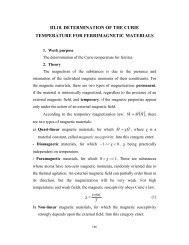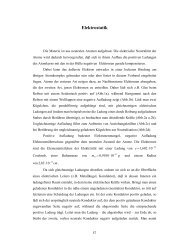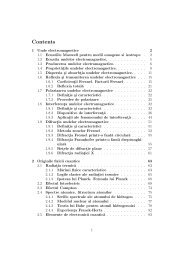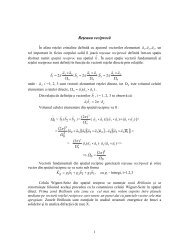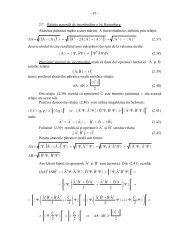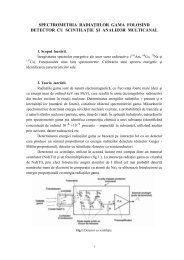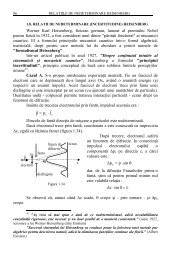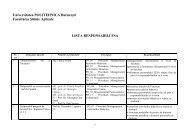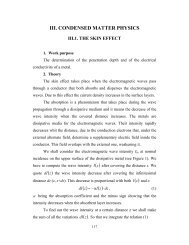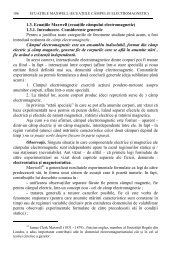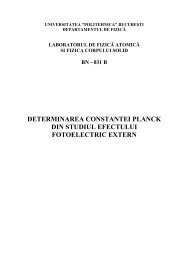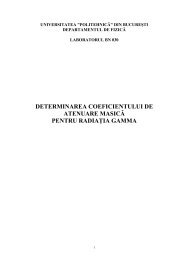Digital holography laboratory
Digital holography laboratory
Digital holography laboratory
Create successful ePaper yourself
Turn your PDF publications into a flip-book with our unique Google optimized e-Paper software.
Research services offered:<br />
<strong>Digital</strong> <strong>holography</strong> <strong>laboratory</strong><br />
(developed through the research contract "Capacities" no. 4/CP/I/2007 -<br />
National Plan RDI)<br />
� Image recording using digital holographic techniques (transmission and/or reflection):<br />
- material study (surface control, optical characterization)<br />
- samples investigation (micro and macroscopic).<br />
� Image reconstruction of the objects from holograms and from the phase information obtained<br />
through processing.<br />
� Fast and slow processes monitoring.<br />
� Design of holographic gratings and devices and of diffractive optical elements<br />
Purpose:<br />
� Initiation and development of research projects and partnerships (private companies included)<br />
� Experimental and theoretical studies for PhD, postdoctoral research and master studies.<br />
� Student practice in optical engineering.<br />
Location: Faculty of Applied Sciences , Physics Department I, room BN 139.<br />
Address: „Politehnica” University of Bucharest, 060042, Spl. Independentei 313.<br />
Team: Mona Mihailescu, Alexandru Preda, Constantin Cristescu, Ion M. Popescu, Dan Stefanoiu, Eugen<br />
Scarlat, Liliana Preda, Irina Paun, Cristina Stan, Aurel Toma.<br />
Contact: Tel. 021 4029102, fax 021 4029120,<br />
Dr. Mona Mihailescu, mona_m@physics.pub.ro ; +4 0722 287 106<br />
Dr. Liliana Preda lily@physics.pub.ro., Dr. Irina Paun, irina.paun@physics.pub.ro<br />
Schedule: daily, in agreement with all partners
Assets and facilities<br />
We equipped this <strong>laboratory</strong> according to latest worldwide requirements in order to use this for various<br />
sample study, in‐situ or in working regime. The holograms can be recorded using transmission or<br />
reflection mode, with many wavelegths, with simple or structured beams.<br />
» Diode pumped solid-state laser Verdi V6 Coherent ‐<br />
» Ultra-short pulsed oscillator, Mantis Coherent<br />
single diode pumped module, ultra-long-life AAA TM laser diode material,<br />
continuum, diffraction limited, output power >6W, wavelength 532 nm,<br />
line width 5 MHz, beam diameter (1/e 2 ): 2,25±10%mm, beam<br />
divergence 0,5mrad, M 2 1,1, power stability (after 2 hrs): ±1%, pointing<br />
0<br />
stability: 100:1, cooling system, range of operating temperature: 15 0 C-<br />
35 0 C, operating voltage 100-240 VAC, power consumption: 13 kW<br />
maximum, 300 W typical.<br />
Ti:Saphire active medium, Avg. Modelocked power >300 mW,<br />
bandwidth
» Scientific video camera (2048x2048 pixel)<br />
CCD high resolution camera<br />
2048x2048/14bit color, 16fps;<br />
transfer rate 100, 200, 400, 800<br />
Mb/s, software for acquisition<br />
and image processing, Pentax<br />
objectives, firewire IEEE1394b<br />
» Spatial light modulators Holoeye<br />
Through transmission LC 2002<br />
LCD display 800x600 pixels, pitch 32μm,<br />
computer addressable 8bit - 256 values, fill<br />
factor 55%, frame rate 60Hz, 2 π Phase Shift<br />
@ 532 nm<br />
Through reflexion Pluto HES 6010<br />
wavelength 420nm - 810nm,<br />
HDTV Developer phase kit,<br />
phase only panel display,<br />
resolution 1920 x 1200, pitch<br />
8.1μm, fill factor: 90%, electronic<br />
driver, PCIe16 graphics card,<br />
frame rate 60 Hz<br />
» Matriceal sensor (CMOS)<br />
Photron Fastcam SA1 (675000fps) -<br />
capture 12bit uncompressed data,<br />
1024x1024pixels, pitch 20x20μm,<br />
data transfer: RS-422A or Gigabit<br />
Ethernet, variable ROI, global<br />
shutter 2 µs, with trigger<br />
» software for holograms reconstruction off‐axis (Koala produced by Lynceetec, Switzerland)<br />
» software for image and hologram processing (VirtualLab produced by LightTrans, Jena)<br />
» Actuator (Physics Instruments) piezoelectric commanded 100x100 μm, step 1μm<br />
» Optical and mechanical components (lenses, beam‐splitters, mirrors, objectives, filters, holographic tables,<br />
positioning stages, shutter)<br />
<strong>Digital</strong> <strong>holography</strong><br />
The principal advantage of digital <strong>holography</strong> is that from a single hologram recorded on a video camera<br />
(CCD or CMOS) we can simultaneously reconstruct (1) amplitude and phase associated with the object<br />
(2) object details situated in planes at different distances along the propagation axis.<br />
In classical <strong>holography</strong> the interference pattern between the reference wave and the one diffracted by<br />
the object is recorded on a holographic plate. This plate is chemically<br />
developed to obtain the hologram. The virtual image of the object are then<br />
experimentally reconstructed and viewed using complex setups.<br />
In digital <strong>holography</strong> the hologram is recorded on a CCD or CMOS matrix; the chemical processes,<br />
which are time consuming, are avoided. Objects are digitally reconstructed,<br />
through an algorithm based on propagation simulation. The digital format of the<br />
image offers the possibility of software comparison with the same object images<br />
in different states.<br />
<strong>Digital</strong> holographic microscopy purpose is to obtain microscopic sample images in coherent light, in<br />
which case the phase information is preserved and nm-range details are<br />
revealed.<br />
Computer generated holograms purpose is to obtain holograms of virtual objects using specific<br />
algorithms, followed by experimental object reconstruction using a spatial light<br />
modulator.<br />
The method implies many scientific and technical domains, including mechanical and optical complexity in<br />
experimental setups, iterative algorithms and specialized software in holograms<br />
and image filtering and processing. The method is complex, combining optics,<br />
electronics, information processing and transmitting (images, numerical data<br />
bases).



